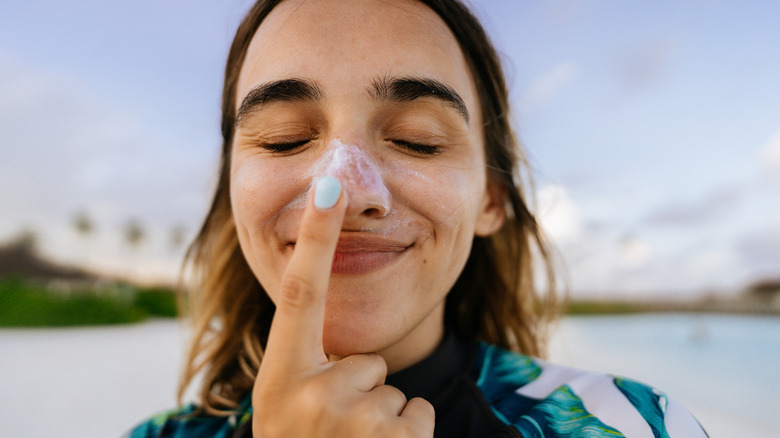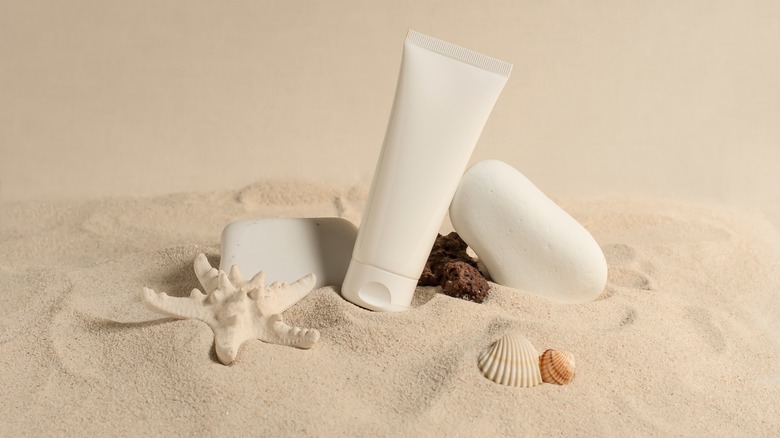Is A Higher SPF Better For Your Skin? We're Setting The Record Straight
Aside from AHA and BHA, one of the most important skincare-related acronyms you should always keep in mind is SPF, which stands for Sun Protection Factor. SPF functions as a barometer for how much your sunscreen can shield your skin from the sun's harmful rays.
According to board-certified dermatologist Dr. Anna Guanche, SPF indicates how long you can have fun under the sun without experiencing sunburn. "For example, using SPF 30 means it will take 30 times as long for your skin to burn than it does with no sunscreen applied," Dr. Guanche explained to Byrdie. "This is a carefully measured number and requires lab testing for what we call MED — minimal erythema dosing." With this in mind, your first instinct may be to pick up a sunscreen with the highest SPF, thinking it can deliver the best protection possible. After all, sunscreen not only helps in dodging painful sunburns and reducing your risk for skin cancer, but it also does wonders in combating the signs of aging, including the development of wrinkles and age spots. SPF lets you hit two birds with one stone, so there's no denying the fact that it needs a permanent place in your skincare routine.
Obviously, you need the most potent protection you can get your hands on, but experts note that you shouldn't be overly reliant on the SPF strength. Rather, if you're concerned about both sunburn and photoaging, you need to look beyond SPF.
Higher doesn't always mean stronger protection against aging
To fully understand how SPF works, you must first comprehend how the sun affects your skin. Dr. Loretta Ciraldo, a board-certified dermatologist, shared with Allure that the sun "emits UVB, UVA, HEV (High Energy Visible Light), and IR (Infrared) rays," with UVB being the chief culprit for sunburn. And yes, while it is true that the higher the SPF, the better you are protected from sunburn, it's a different story if you throw skin aging into the mix.
A sunscreen boasting an SPF of over 50 may prevent your skin from redness and peeling after lengthy exposure to the sun, but it can't do much about keeping it from developing wrinkles. "UVA rays penetrate even more deeply and are responsible for most skin aging, hyperpigmentation, damage to collagen fibers, and more aggressive skin cancers including melanomas," added Dr. Ciraldo.
What's more, your protection against UVA rays gets compromised the moment you lather on sunscreens with higher SPFs. Dr. Orit Markowitz, director of Pigmented Lesions and Skin Cancer at Mount Sinai pointed out to Insider that "as the SPF number goes up, protection against UVA goes down because of the way that the protective ingredients in the sunscreen interact which is why SPF 100 is not recommended."
How to pick and apply sunscreen
If you want to ensure that you're getting the proper protection you need, it's important to take a closer look at how the sunscreen is formulated, and not the SPF number. The Skin Cancer Foundation recommends selecting a sunscreen that offers "broad spectrum" protection as it's a guarantee that you will be protected from both UVB and UVA rays. The FDA thoroughly vets sunscreens that market themselves as "broad spectrum" so if a bottle has that label, it means that it passed stringent testing to prove that its UVB protection is commensurate to its UVA protection, delivering the all-around sunburn and aging defense your skin demands.
"I would rather you choose an SPF 15 product that protects against UVA rays and UVB rays as opposed to a higher SPF that doesn't give you UVA protection," Dr. Joshua Zeichner, board-certified dermatologist and the director of cosmetic and clinical research of dermatology at Mount Sinai Hospital shared with Allure.
The way you apply sunscreen matters, too. If fighting against aging is your priority, cosmetic dermatologist Dr. Sam Bunting told Glamour that a quarter of a teaspoon for the face (and another quarter for the neck) is the ideal amount. "You can use the two-finger — your index and middle fingers — rule for ease," Dr. Bunting said. "I recommend people use the 13-dot technique to ensure you cover the skin evenly, without missing bits out. Just like painting a wall, you want (and need) an even layer."

